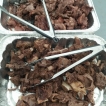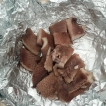MERCURY in hair
The FNFNES Mercury in Human Hair Component
One of the significant limitations of the current information on methylmercury exposures among First Nations peoples is that they are based on volunteer sampling and cannot be extrapolated to represent populations, even at a regional level. Furthermore, no systematic sampling across the country has been done since the end of Methylmercury in Canada Program in 1998/1999. There is a need to undertake bio-monitoring initiative for methylmercury in order to examine the current trend in relation to the previously collected information.
Specifically in regard to this study, the collection of bio-monitoring information allows to validate the outcomes of dietary questionnaires and, therefore, better deal with identification of outliers in the population.
Therefore, the FNFNES includes a non-invasive bio-monitoring component, relying on sampling of human hair for analysis for mercury in order to use this information for additional validation of dietary assessments and to develop a new estimate of First Nations populations’ exposure to methylmercury across Canada.
Overview of Sampling Procedure
The hair will be collected according to the established procedure of the First Nations and Inuit Health Branch (FNIHB) Laboratory, formerly known as the Laboratory Services of the Medical Service Branch. In essence, a 5 mm bundle of hair will be isolated and cut from the occipital region, ensuring a minimal, and most often unnoticeable, effect on participants’ aesthetics. The hair bundle (full length, as cut from the scalp) will be placed in a polyethylene bag and fastened to the bag with three-to four staples near the scalp end of the hair bundle. The hair sample accompanied by a duly filled Chain of Custody form will be sent to the FNIHB Laboratory.
Total and inorganic Hg in the hair, will be analyzed by the FNIHB Laboratory in Ottawa, Canada. Each hair bundle will be cut into 1 cm segments, starting from the scalp end, an analysed to provide the levels of mercury in participant’s hair for approximately the last three months.
Segmented hair samples will be digested to release ionic mercury species. The ionic mercury species will selectively be reduced to elemental mercury. The elemental mercury will be measured by Cold Vapor Atomic Fluorescence Spectrophotometry (CVAFS). Selective reduction of the ionic mercury species allows for the measurement of Total or Inorganic mercury in hair. The limit of detection is 0.02 ppm for total or inorganic mercury in hair.
Any unused hair left from the original bundle will be reattached to the polyethylene bag, and the unused segments will be kept in small envelopes in the polyethylene bag. Those will be stored in the FNIHB Laboratory for the duration of the study, to ensure that should there be requests for re-analysis from participants, they could be addressed. At the end of the study the remaining samples will be returned to participants or destroyed in accordance with First Nations spiritual practices. In order to determine which specific course of action to take, a question will be posed at the community meetings for results reporting to First Nations communities.






